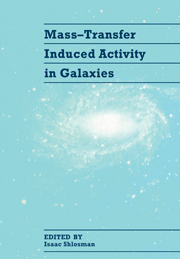Book contents
- Frontmatter
- Contents
- Preface
- List of Participants
- I INTRODUCTION
- II THE INNER PARSEC
- III THE CIRCUMNUCLEAR REGION
- IV GAS DYNAMICS AND STAR FORMATION IN BARRED AND NORMAL GALAXIES
- Star Formation in Barred Galaxies (Invited paper)
- Gas Dynamics and Star Formation in and Around Bars (Invited paper)
- Nuclear Starbursts in Barred Spiral Galaxies
- Molecular Inflows towards Galactic Nuclei
- Bar-Driven and Interaction-Driven Starbursts in SO/Sa Galaxies
- Gas Inflow due to Perpendicular Orbits in Barred Potentials
- Neutral Gas in the Barred Starburst Galaxy Maffei 2 (Poster paper)
- The Abundance Gradients in Barred Galaxies: the Role of Radial Flows (Poster paper)
- Bar Induced Non–Circular Molecular Gas Motions in M82 (Poster paper)
- Star Complexes and Evolution of Disk Galaxies (Poster paper)
- Interstellar Gas Flows in the Gravitational Potential Well of Density Waves (Poster paper)
- Massive Gas Rings in the Nuclei of Barred Spiral Galaxies (Poster paper)
- Pattern Speeds and Time Evolution in Ringed Galaxies from Observational and Simulational Databases (Poster paper)
- Large Scale Gravitational Instability and Galactic Viscosity (Poster paper)
- V NUCLEAR GAS AND LARGE-SCALE PROPERTIES OF AGN AND STARBURST HOSTS
- VI HOST GALAXY-AGN-NUCLEAR STARBURST CONNECTION
- VII GALAXY INTERACTIONS AND INDUCED ACTIVITY
- VIII GAS DYNAMICS IN ELLIPTICALS
- IX AGN AND STARBURST HOSTS AT LARGE REDSHIFTS
- X CONFERENCE SUMMARY
- Subject Index
- Object Index
- Author Index
Gas Inflow due to Perpendicular Orbits in Barred Potentials
Published online by Cambridge University Press: 05 May 2010
- Frontmatter
- Contents
- Preface
- List of Participants
- I INTRODUCTION
- II THE INNER PARSEC
- III THE CIRCUMNUCLEAR REGION
- IV GAS DYNAMICS AND STAR FORMATION IN BARRED AND NORMAL GALAXIES
- Star Formation in Barred Galaxies (Invited paper)
- Gas Dynamics and Star Formation in and Around Bars (Invited paper)
- Nuclear Starbursts in Barred Spiral Galaxies
- Molecular Inflows towards Galactic Nuclei
- Bar-Driven and Interaction-Driven Starbursts in SO/Sa Galaxies
- Gas Inflow due to Perpendicular Orbits in Barred Potentials
- Neutral Gas in the Barred Starburst Galaxy Maffei 2 (Poster paper)
- The Abundance Gradients in Barred Galaxies: the Role of Radial Flows (Poster paper)
- Bar Induced Non–Circular Molecular Gas Motions in M82 (Poster paper)
- Star Complexes and Evolution of Disk Galaxies (Poster paper)
- Interstellar Gas Flows in the Gravitational Potential Well of Density Waves (Poster paper)
- Massive Gas Rings in the Nuclei of Barred Spiral Galaxies (Poster paper)
- Pattern Speeds and Time Evolution in Ringed Galaxies from Observational and Simulational Databases (Poster paper)
- Large Scale Gravitational Instability and Galactic Viscosity (Poster paper)
- V NUCLEAR GAS AND LARGE-SCALE PROPERTIES OF AGN AND STARBURST HOSTS
- VI HOST GALAXY-AGN-NUCLEAR STARBURST CONNECTION
- VII GALAXY INTERACTIONS AND INDUCED ACTIVITY
- VIII GAS DYNAMICS IN ELLIPTICALS
- IX AGN AND STARBURST HOSTS AT LARGE REDSHIFTS
- X CONFERENCE SUMMARY
- Subject Index
- Object Index
- Author Index
Summary
ABSTRACT
Radial gas flows can be induced in a galactic disk by a bar potential, and its implied gravitational torques. All gas inside corotation is driven towards the center, and forms a nuclear ring at the inner Lindblad resonance (ILR). When the mass concentration is high enough, there exists two ILRs, and the existence of periodic orbits perpendicular to the bar makes the gas response to shift in phase with respect to the stellar main bar. This produces a strong torque on the gas, and drives a rapid nuclear gas flow inside ILR. With a more viscous gas, however, a second bar of stars and gas can decouple from the primary one, with a higher pattern speed. In this “bar within bar” configuration, the gas is in phase with the stellar component, and the gravity torques are minimised. The gas inside the second corotation flows slowly inwards. The nuclear bar is relatively long- lived, which explains its frequent occurence in observed barred spirals.
NUCLEAR BARS AND THEIR POSSIBLE INTERPRETATIONS
Bars are the way to redistribute angular momentum in a galaxy, and to reshape the mass distribution. The induced gas flow towards the center is the cause of star-bursts, hot spots in nuclear rings, and may be of nuclear activity. A clue to the detailed mechanisms of the central gas flow is the observation of nuclear bars and central isophote twists. This phenomenon in barred spiral galaxies has been observed for a long time. Already de Vaucouleurs (1974) had noticed bars within bars, and Sandage and Brucato (1979) high surface brightness nuclear bars, as independent entities.
- Type
- Chapter
- Information
- Mass-Transfer Induced Activity in Galaxies , pp. 170 - 174Publisher: Cambridge University PressPrint publication year: 1994
- 33
- Cited by

